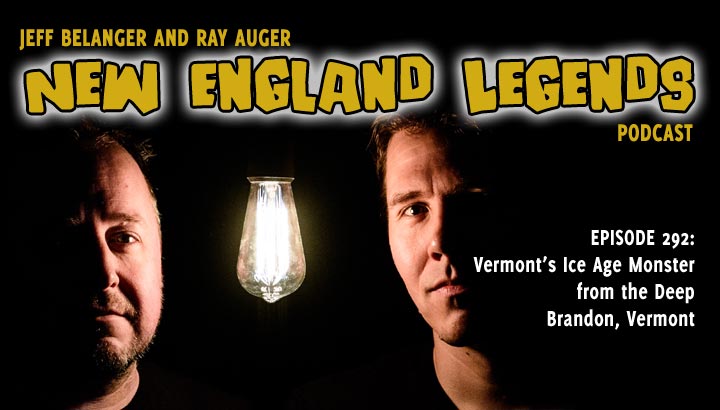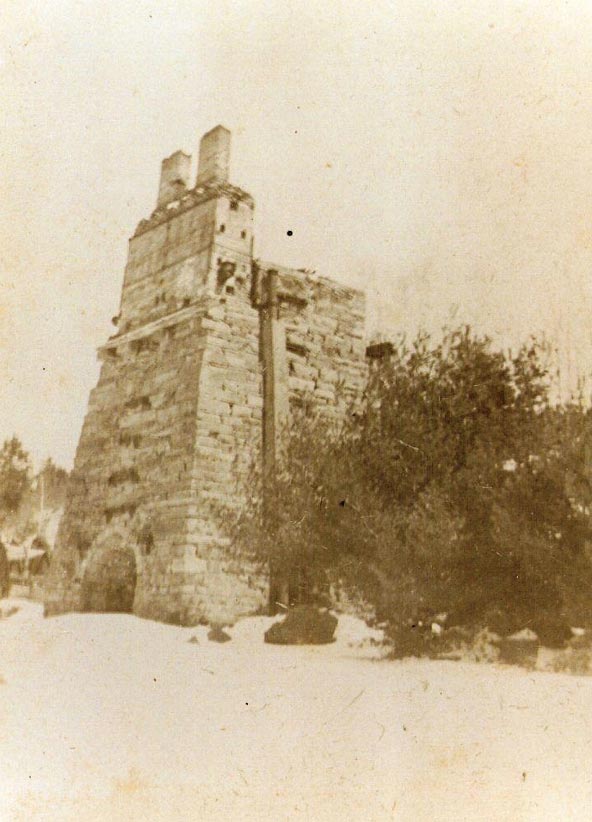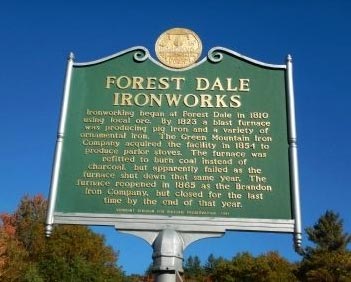

In Episode 292 Jeff Belanger and Ray Auger dig down 114 feet in the Forest Dale section of Brandon, Vermont, to search for an Ice Age-era frog they say was discovered back in the summer of 1865 deep in an ochre mine. But when the frog was brought to the surface… it jumped back to life! Is this just one weird fish story, or something more?
BECOME A LEGENDARY PATRON:
https://www.patreon.com/NewEnglandLegends
CREDITS:
Produced and hosted by: Jeff Belanger and Ray Auger
Edited by: Ray Auger
Theme Music by: John Judd
SUBSCRIBE TO THE PODCAST FOR FREE:
Apple Podcasts/iTunes | Google Podcasts | Spotify | Pandora | Stitcher | Amazon Podcasts | TuneIn | iHeartRadio
JOIN OUR SUPER-SECRET:
New England Legends Facebook Group



EPISODE TRANSCRIPT:
*A note on the text: Please forgive punctuation, spelling, and grammar mistakes. Like us, the transcripts ain’t perfect.
[DRIVING IN CAR]
RAY: I see some shovels in the backseat. A pick axe. We’ve got some buckets. Are we going to bury a body or something?
JEFF: Or maybe dig one up!
RAY: Even better!
JEFF: When I was a kid, I used to love digging holes. I think I may have been a miner in a past life. Which is what brings us to the small town of Brandon in eastern Vermont, today, Ray.
RAY: We’re going mining?
JEFF: We are. Sort of. And while we’re heading to a former ochre mine in Brandon, ochre is NOT what we’ll be digging for.
RAY: No? Then what are we digging for?
JEFF: Ray, we’ve come to Brandon, Vermont, to dig for a prehistoric animal discovered deep in the ground back in 1865. An animal they say came back to life once it reached the surface. We’re searching for Vermont’s giant ice age frog.
[GIANT BULLFROG RIBBIT]
[INTRO]
JEFF: I’m Jeff Belanger.
RAY: And I’m Ray Auger. Welcome to Episode 292 of the New England Legends podcast. Thanks for joining us on our mission to chronicle every legend in New England one story at a time.
JEFF: Whether it’s cryptids and monsters, ghosts and haunting, UFOs and aliens, roadside oddities, true crime, or just plain weird history, we love it all. Please subscribe and share this podcast, and post a review for us. The more we grow, the more people who share their own weird stories.
RAY: Before we go looking for a giant Ice Age frog, we want to take just a minute to tell you about our sponsor, Nuwati Herbals!
JEFF: Ray, do you ever find yourself in the mood for something a little different when it comes to your hot drinks?
RAY: Absolutely. Tea, hot cocoa, coffee, it all depends on my mood and the day.
JEFF: I get that. It’s seasonal too.
RAY: Lately I’ve been loving Cherokee Ground Herbal Coffee from Nuwati Herbals!
JEFF: It’s a great alternative to traditional coffee. Because it’s got all natural ingredients like Yerba Mate, Guayusa, and black tea, it’s got plenty of caffeine kick, and it tastes like a cross between a strong black tea and a cup of coffee.
RAY: I like that you can make it in your coffee maker, percolator, French press, espresso machine, or a tea infuser. It doesn’t have to steep like traditional tea. And the flavor is amazing. Like you said, it’s tea meets coffee. I like to add a little sugar and milk to make it complete.
JEFF: Let Nuwati Herbals help support your healthy lifestyle. Check out the Nuwati Herbals Web site to see all of their great products AND you get 20% off your order when you use the promo code LEGENDS20 at checkout. Visit Nuwati Herbals dot com. That’s N-U-W-A-T-I Herbals with an S dot com.
[DRIVING IN CAR]
RAY: Okay, Jeff. We’re searching for a giant, pre-historic, Ice Age bullfrog in Brandon, Vermont?
JEFF: We are! This is a weird one. A strange tale to be sure. But one that made the newspaper, and it’s a story that’s been around for a century and an half now.
RAY: So the last Ice Age hit its peak around 20,000 years ago. That’s a time when pretty much all of New England would have been covered in glaciers. Those glaciers have been receding ever since. Those same glaciers gave us the Great Lakes, plus countless other lakes. They helped transform the landscape, gave us farm land, and so much more. The Earth used to be a colder place.
JEFF: That it was. Okay so we’re driving up Route 73 and just passed into the Foresdale section of Brandon, Vermont. There’s the Furnace Road intersection, so our destination is coming up on the left. (PAUSE) Yup. See that field?
RAY: I do.
JEFF: We can pull over here.
[CAR STOPS DOORS CLOSE]
RAY: I see an open field surrounded by trees on all sides.
JEFF: Right, and there’s an historic marker right there.
RAY: Oh I see it! It reads: Forest Dale Ironworks. Ironworking began at Forest Dale in 1810 using local ore. By 1823 a blast furnace was producing pig iron and a variety of ornamental iron. The Green Mountain Iron Company acquired the facility in 1854 to produce parlor stoves. The furnace was refitted to burn coal instead of charcoal, but apparently failed as the furnace shut down that same year. The furnace reopened in 1865 as the Brandon Iron Company, but closed for the last time by the end of that year.
JEFF: Let’s grab the shovels and head across the field.
[HIKING]
RAY: Okay, just down the hill I can see the roof of an old stone tower. I guess that must have been the blast furnace.
JEFF: It is! It’s a big stone chimney with stone arches at the base that are closed off with a metal gate. And a small roof structure at the top maybe 20 feet up. This building is now on the National Register of Historic Places.
RAY: And we’re going to dig here?
JEFF: That’s the thing. This odd amphibious artifact was said to have been discovered 114 feet below the surface in the ochre mine.
RAY: Okay, I’m NOT digging 114 feet down.
JEFF: I get that. Plus, these mines have all been sealed up at this point. So let’s head back to when they were open in 1865, and dig for this frog.
[TRANSITION]
RAY: It’s July of 1865, and America is beginning its long recovery from the Civil War that ended back in April. President Lincoln was assassinated at Ford’s Theater in Washington D.C. on April 14th, and now President Andrew Johnson sits in the White House. Here in Forest Dale, Vermont, the iron and ochre mines are busy.
JEFF: That they are. America is rebuilding and trying to come back together. The first blast furnace in Forest Dale was built in 1810. The one we see here now was built in 1845 to replace the earlier one. The smelter processes ore with local charcoal to make pig iron. From there that iron can become stoves, cooking pots, chains, axes, other small tools, and even small cannons.
RAY: So these mines and smelter are literally helping to build the region and Vermont.
JEFF: They are. Then there’s the ochre mine here too.
RAY: Right. Why would they mine ochre?
JEFF: Ochre, when ground into powder creates an adhesive resin you can use to mount tools onto handles and things like that.
RAY: Got it.
JEFF: Let’s head below ground.
[FADE IN DIGGING, CHISELING ON STONE]
RAY: The temperatures are pretty cool down here.
JEFF: Yeah, this far down the temperatures stay pretty constant. So it’s not so bad working down here on a hot summer day. (BEAT) Okay, we just passed the 110-foot level.
RAY: It’s kind of scary with so much earth above us. It looks like the workers are digging a new shaft off the main tunnel.
JEFF: Yeah, mining is tricky work. You have to watch for cave-ins all the time. One false move with the shovel and you could kill yourself and others around you.
[DIG DIG DIG]
WORKER: What… is THIS?!
JEFF: it looks like that miner just hit a muddy pocket over there. (BEAT) Oh, man… if he just hit an underwater vein we could be in big trouble if this place floods in seconds.
RAY: It doesn’t look like any flood waters are coming through. Just mud. But look… is that a rock he’s pulling out of the mud?
JEFF: It sort of looks like a rock. But wait… he’s wiping some of the mud off. Is that…?
RAY: Is that a frog?!
JEFF: I think it is!
RAY: It’s huge! It’s got to be over a foot long!
JEFF: Look at that… it’s not a fossil… but it’s not breathing either. It’s somehow perfectly preserved down here. Let’s get this thing back above the surface and get a better look at it.
[DIGGING FADES OUT]
JEFF: Can you pass me the water jug? (Thanks!
[POURING WATER]
RAY: Woahhhh…. That’s the biggest frog I’ve ever seen. It’s huge! I gotta measure this thing. (BEAT) Okay, it’s 14 inches from the tip of its mouth to its butt. If we extend the legs, then this thing would be maybe two-and-a-half or three feet long.
JEFF: Let’s not pull at its legs. This find should be studied in a museum or something.
RAY: It’s definitely drawing a crowd of curious miners and locals. No one has every seen any frog this big.
JEFF: Kids from town are checking the thing out. Daring each other to touch it, then running away squealing.
RAY: I get it. It’s not something you see every day.
BOSS: Okay men, back to work!
RAY: I guess progress waits for no one. The miners are getting back to their jobs.
[DIGGING, WORKING SOUNDS]
RAY: But what a strange find so deep in the ground! How could that frog have gotten there? I have so many….
[GIANT BULLFROG RIBBIT]
JEFF/RAY: What was that?!
JEFF: Noooooo….
RAY: I don’t believe it. That giant frog is twitching. It’s….
[MORE GIANT BULLFROG RIBBIT]
JEFF: It’s jumping backward and almost convulsing. That thing is alive!
RAY: Look! It seems to be getting its bearings now.
[GIANT BULLFROG RIBBIT]
JEFF: It looks like we’re drawing a crowd again. Some of the workers are carrying it in a sack to a nearby pond. Let’s follow them…
[WALKING]
[SPLASH]
RAY: Wow. And there he goes!
JEFF: That giant bullfrog just swam off in the pond. Let’s head back in town for a beer. I can’t wait to hear what locals think of this.
[FADE IN BAR SOUNDS]
JEFF/RAY: Cheers
[CLINK]
RAY: One guy I spoke to said he believes the giant frog is a left over from before the last Ice Age. The glaciers came through and froze that amphibian until it was unearthed this summer.
JEFF: That sounds crazy. But seriously, this frog is bigger than any frog anyone has ever seen. And everyone around here has a story about seeing a fish frozen in the ice of a pond or lake for the winter, then spring comes and the fish swims off. Maybe it’s not that much of a stretch that if the fish… or in this case frog… was frozen for years, maybe even centuries, then couldn’t the same mechanics still be involved?
RAY: But this frog was found in a pocket of mud, right?
JEFF: Right. Maybe just at the edge of some leftover permafrost layer, and the mining operation warmed it just enough to melt? This is a big mystery for sure.
RAY: As more weeks go by, the buzz around this giant frog starts to fade. BUT locals claim you can still hear that mammoth bullfrog bellow at night. It still echoes for miles around.
[GIANT BULLFROG RIBBIT WITH ECHO]
JEFF: And that brings us back to today.
[TRANSITION]
RAY: Okay… I have questions.
JEFF: Me too. But first, we should say that everything we know about this story comes from the November 16, 1922 Enterprise and Vermonter newspaper. And though the mines are closed, this smelting tower is still here and is now an historic landmark.
RAY: Wait… 1922 is almost 60 years after 1865 when the story takes place!
JEFF: Yes it is. This article’s source is Frank Rogers of Brandon, Vermont. He was a retired merchant at the time, but grew up in Forestdale. Rogers claims he was there as a kid and witnessed the giant frog after they pulled it from the ground. He also said they could hear that frog for several summers after.
RAY: So we’re counting on the memory of an old man at this point?
JEFF: We are. The next question that’s begged here is: How big can a bullfrog get? I’ve seen some big ones near the old pond where I grew up. I mean, nothing over a foot from nose to butt. But still… could there be bigger ones out there?
RAY: Okay, I looked this up. In North America, the largest bullfrogs can grow to 6 to 8-inches in length—that’s tip of the nose to its butt. And weigh 2 to 3 pounds.
JEFF: That’s pretty big! But about half the size as the frog described in this article.
RAY: BUT… in Guinea and Cameroon, there’s a species of frog called the Goliath Bullfrog that can grow to about 12 and a half inches in length and weigh just over 7 pounds.
JEFF: Wow! That’s really huge, but still slightly smaller than the one described in Vermont.
RAY: But still, that means a frog CAN grow to the size described. And who knows what frogs may have looked like millennia ago. The next question is how long could a frog or fish for that matter, stay frozen and still come back to life?
JEFF: I looked this up. There are currently five species of frogs in North America that can and do survive freezing in the winter to thaw out in the spring and carry on.
RAY: Right, but that’s one winter.
JEFF: So theoretically a frog can be frozen for a long time and still come back to life. But what happens is ice crystal eventually form inside their insulated bodies that damage the cells. So eventually that cell damage would lead to death. Now, could a frog be kept right at the borderline of freezing, but still slow its body functions down almost to the point of stopping? Hibernation? Maybe. But for centuries or even millennia? There’s never been a case in modern history….
RAY: Which means this is either a fish story where the circumstances grew and grew over time… or… Brandon, Vermont, was home to one big hunk of bull… frog.
[GIANT BULLFROG RIBBIT WITH REVERB]
[OUTTRO]
JEFF: You gotta love it when a frog story goes viral from 100 years ago.
RAY: And that bring us to After the Legend where we dig a little deeper into this week’s story and sometimes jump off course.
JEFF: After the Legend is brought to you by our mighty Patreon Patrons who are the life blood of everything we do here. They help us with our production, hosting, and marketing costs, and really make a difference. They understand great content isn’t free. So thank you. They pay so you can listen. It’s just $3 bucks per month! That’s like buying me and Ray a package of marshmallow peeps that we have to split. For that, you’ll get early access to new episodes plus bonus episodes and content that no one else gets to hear. Just head over to patreon.com/NewEnglandLegends to sign up.
If you’ve got a strange tale you think we should check out, please don’t assume we’ve heard it. Reach out to us anytime through our Web site. Also, please subscribe to our podcast wherever you get your podcasts because it’s free and we don’t want you to miss a thing.
Thank you to Matt from the Scary Movie Project Podcast for interviewing me in his recent episode. Thanks to our sponsor Nuwati Herbals, thanks to our patreon patrons, and our theme music is by John Judd.
Until next time remember… the bizarre is closer than you think.
